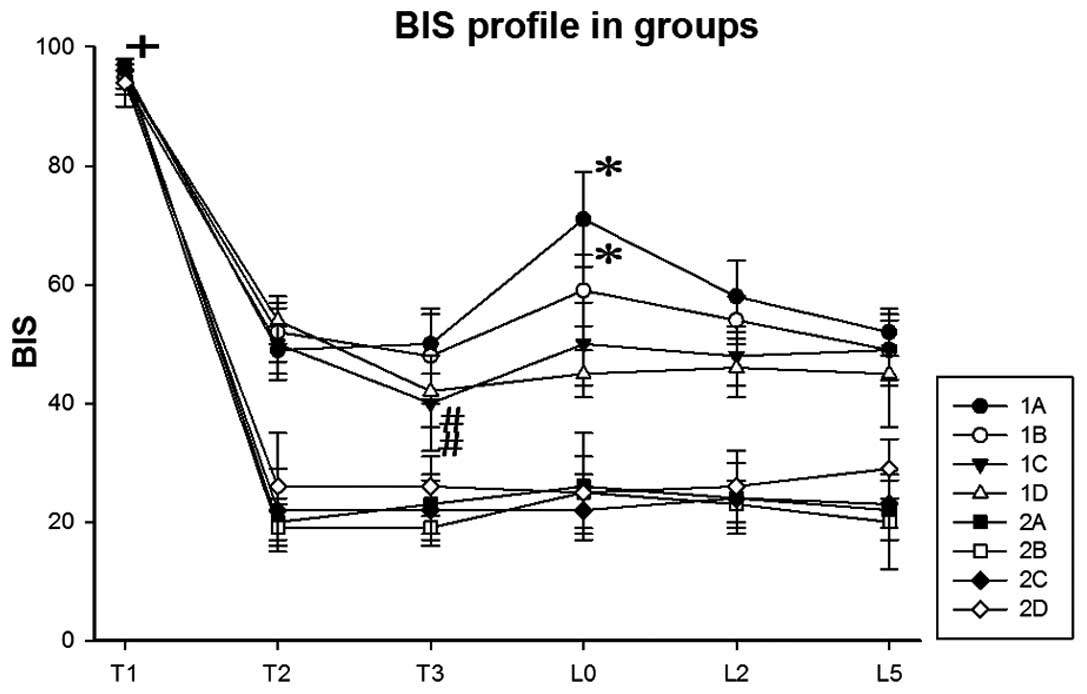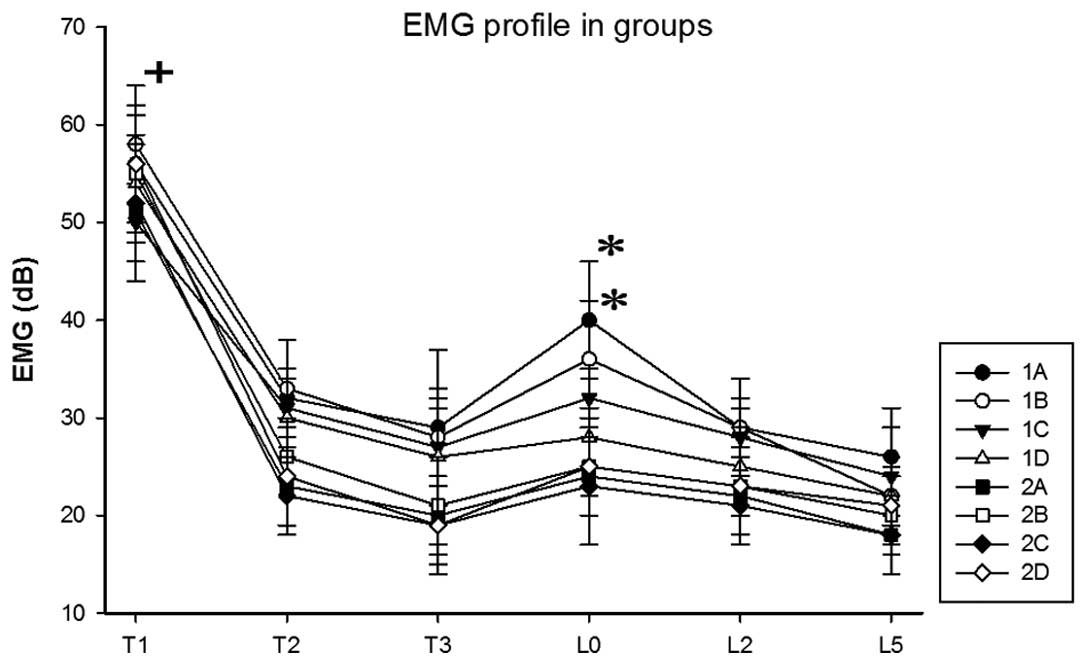|
1
|
Huang YF, Pryor ME, Mather LE and Veering
BT: Cardiovascular and central nervous system effects of
intravenous levobupivacaine and bupivacaine in sheep. Anesth Analg.
86:797–804. 1998. View Article : Google Scholar : PubMed/NCBI
|
|
2
|
Gazzanelli S, Vari A, Tarquini S,
Fermariello A, Caputo M, Almansour M, Costi U, Basso L, Casullo L
and Izzo L: Monitoring of consciousness with BIS during induction
of anesthesia. G Chir. 26:163–169. 2005.PubMed/NCBI
|
|
3
|
Gao JD, Zhao YJ, Xu CS, Zhao J, Huang YG,
Wang TL, Pei L, Wang J, Yao LN, Ding Q, et al: Evaluation of
entropy for monitoring the depth of anesthesia compared with
bispectral index: A multicenter clinical trial. Chin Med J (Engl).
125:1389–1392. 2012.PubMed/NCBI
|
|
4
|
Hans P, Giwer J, Brichant JF, Dewandre PY
and Bonhomme V: Effect of an intubation dose of rocuronium on
spectral entropy and bispectral index responses to laryngoscopy
during propofol anaesthesia. Br J Anaesth. 97:842–847. 2006.
View Article : Google Scholar : PubMed/NCBI
|
|
5
|
Pomfrett CJ: Heart rate variability, BIS
and 'depth of anaesthesia'. Br J Anaesth. 82:659–662. 1999.
View Article : Google Scholar : PubMed/NCBI
|
|
6
|
Sie MY, Goh PK, Chan L and Ong SY:
Bispectral index during modified rapid sequence induction using
thiopentone or propofol and rocuronium. Anaesth Intensive Care.
32:28–30. 2004.PubMed/NCBI
|
|
7
|
Forbes A, Cohen N and Eger EI II:
Pancuronium reduces halothane requirement in man. Anesth Analg.
58:497–499. 1979. View Article : Google Scholar : PubMed/NCBI
|
|
8
|
Riess ML, Graefe UA, Goeters C, Van Aken H
and Bone HG: Sedation assessment in critically ill patients with
bispectral index. Eur J Anaesthesiol. 19:18–22. 2002. View Article : Google Scholar : PubMed/NCBI
|
|
9
|
Prell J, Rampp S, Ache J, Laule S,
Rachinger J, Scheller C, Alfieri A and Strauss C: The potential of
quantified lower cranial nerve EMG for monitoring of anesthetic
depth. J Neurosurg Anesthesiol. 24:139–145. 2012. View Article : Google Scholar : PubMed/NCBI
|
|
10
|
Vivien B, Di Maria S, Ouattara A, Langeron
O, Coriat P and Riou B: Overestimation of Bispectral Index in
sedated intensive care unit patients revealed by administration of
muscle relaxant. Anesthesiology. 99:9–17. 2003. View Article : Google Scholar : PubMed/NCBI
|
|
11
|
Park SJ, Cho YJ, Oh JH, Hwang JW, Do SH
and Na HS: Pretreatment of magnesium sulphate improves intubating
conditions of rapid sequence tracheal intubation using alfentanil,
propofol, and rocuronium-a randomized trial. Korean J Anesthesiol.
65:221–227. 2013. View Article : Google Scholar : PubMed/NCBI
|
|
12
|
Kawaguchi M, Takamatsu I and Kazama T:
Rocuronium dose-dependently suppresses the spectral entropy
response to tracheal intubation during propofol anaesthesia. Br J
Anaesth. 102:667–672. 2009. View Article : Google Scholar : PubMed/NCBI
|
|
13
|
Pearsall FJ, Davidson JA and Asbury AJ:
Attitudes to the Association of Anaesthetists recommendations for
standards of monitoring during anaesthesia and recovery.
Anaesthesia. 50:649–653. 1995. View Article : Google Scholar : PubMed/NCBI
|
|
14
|
Chun H, Kang J, Kim KJ, Park KS and Kim
HC: IT-based diagnostic instrumentation systems for personalized
healthcare services. Stud Health Technol Inform. 117:180–190.
2005.PubMed/NCBI
|
|
15
|
Iannuzzi M, Iannuzzi E, Rossi F, Berrino L
and Chiefari M: Relationship between bispectral index,
electroencephalographic state entropy and effect-site EC50 for
propofol at different clinical endpoints. Br J Anaesth. 94:492–495.
2005. View Article : Google Scholar : PubMed/NCBI
|
|
16
|
Morimoto Y, Hagihira S, Koizumi Y, Ishida
K, Matsumoto M and Sakabe T: The relationship between bispectral
index and electroencephalographic parameters during isoflurane
anesthesia. Anesth Analg. 98:1336–1340. 2004. View Article : Google Scholar : PubMed/NCBI
|
|
17
|
Rampil IJ: A primer for EEG signal
processing in anesthesia. Anesthesiology. 89:980–1002. 1998.
View Article : Google Scholar : PubMed/NCBI
|
|
18
|
Hosseinzadeh H and Asl M Nassiri:
Anticonvulsant, sedative and muscle relaxant effects of
carbenoxolone in mice. BMC Pharmacol. 3:32003. View Article : Google Scholar : PubMed/NCBI
|
|
19
|
Sanford TJ Jr, Weinger MB, Smith NT,
Benthuysen JL, Head N, Silver H and Blasco TA: Pretreatment with
sedative-hypnotics, but not with nondepolarizing muscle relaxants,
attenuates alfentanil-induced muscle rigidity. J Clin Anesth.
6:473–480. 1994. View Article : Google Scholar : PubMed/NCBI
|
|
20
|
Dahaba AA, Mattweber M, Fuchs A, Zenz W,
Rehak PH, List WF and Metzler H: The effect of different stages of
neuromuscular block on the bispectral index and the bispectral
index-XP under remifentanil/propofol anesthesia. Anesth Analg.
99:781–787. 2004. View Article : Google Scholar : PubMed/NCBI
|
|
21
|
Dahaba AA, Bornemann H, Hopfgartner E,
Ohran M, Kocher K, Liebmann M, Wilfinger G and Metzler H: Effect of
sugammadex or neostigmine neuromuscular block reversal on
bispectral index monitoring of propofol/remifentanil anaesthesia.
Br J Anaesth. 108:602–606. 2012. View Article : Google Scholar : PubMed/NCBI
|
|
22
|
Aho AJ, Kamata K, Yli-Hankala A,
Lyytikäinen LP, Kulkas A and Jäntti V: Elevated BIS and Entropy
values after sugammadex or neostigmine: An electroencephalographic
or electromyographic phenomenon? Acta Anaesthesiol Scand.
56:465–473. 2012. View Article : Google Scholar : PubMed/NCBI
|
|
23
|
Mi WD, Sakai T, Takahashi S and Matsuki A:
Haemodynamic and electroencephalograph responses to intubation
during induction with propofol or propofol/fentanyl. Can J Anaesth.
45:19–22. 1998. View Article : Google Scholar : PubMed/NCBI
|
|
24
|
Guignard B, Menigaux C, Dupont X, Fletcher
D and Chauvin M: The effect of remifentanil on the bispectral index
change and hemodynamic responses after orotracheal intubation.
Anesth Analg. 90:161–167. 2000. View Article : Google Scholar : PubMed/NCBI
|
|
25
|
Ekman A, Lindholm ML, Lennmarken C and
Sandin R: Reduction in the incidence of awareness using BIS
monitoring. Acta Anaesthesiol Scand. 48:20–26. 2004. View Article : Google Scholar : PubMed/NCBI
|
|
26
|
Sugiura S, Hidaka K, Seki S and Tsuchida
H: Comparative study of two beta adrenergic antagonists on
hemodynamics at the endotracheal intubation. Anesthesiology.
107:A3092007.
|
|
27
|
Messieha ZS, Guirguis S and Hanna S:
Bispectral index monitoring (BIS) as a guide for intubation without
neuromuscular blockade in office-based pediatric general
anesthesia: A retrospective evaluation. Anesth Prog. 58:3–7. 2011.
View Article : Google Scholar : PubMed/NCBI
|
|
28
|
Messner M, Beese U, Romstöck J, Dinkel M
and Tschaikowsky K: The bispectral index declines during
neuromuscular block in fully awake persons. Anesth Analg.
97:488–491. 2003. View Article : Google Scholar : PubMed/NCBI
|
|
29
|
Albertin A, Casati A, Federica L, Roberto
V, Travaglini V, Bergonzi P and Torri G: The effect-site
concentration of remifentanil blunting cardiovascular responses to
tracheal intubation and skin incision during bispectral
index-guided propofol anesthesia. Anesth Analg. 101:125–130. 2005.
View Article : Google Scholar : PubMed/NCBI
|
















